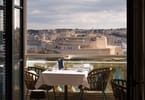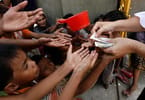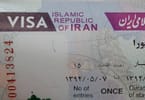Wearing matching baseball hats for easy identification, Chinese tour groups are an increasingly common sight.
They trudge around Beijing’s imperial sites, tramp up Buddhist mountains and take whistle-stop tours of Europe.
With money in their pockets and the freedom to travel, Chinese people are also journeying into their country’s past.
And there has been a rise in so-called red tourism – trips to places linked with China’s communist history.
Nowhere is more sacred than Yan’an, the small, remote city in Shaanxi province where Mao Zedong’s Red Army ended up in 1935.
The Communist Party planned its takeover of China from Yan’an, and tourists throng there to find out how it was done.
Communists across the world usually shun religion, but people travelling to Yan’an often seem like pilgrims visiting a holy site.
No place is more sacred than Zaoyuan, a former orchard where Mao and his colleagues lived in caves carved out of the soft mountainside.
The cave where Mao lived is open to the public.
Tourists walk through the three small, whitewashed rooms where the revolutionary leader lived and worked.
The bedroom appears to be as it was in Mao’s day. As well as a bed, there is a deckchair, a wooden bath and a family portrait on one wall, showing Mao with his fourth wife and one of his numerous children.
Outside the cave, groups pose together for photographs. Some pay to dress up in old-style military uniforms.
“I’m touched that our predecessors could think about the nation while living in such harsh conditions,” said Zhu Junchun, who was with a tour group from the Chinese Aviation Industry Corporation in Guangdong province.
“The conditions they endured made the party what it is today.”
‘Inevitable outcome’
Like married couples keen to renew their wedding vows, party members also go to Yan’an to renew their pledge of allegiance to the party.
A steady stream of coaches pulls up at a communist memorial just outside Yan’an and groups of party members, some of them wearing identical shirts, poured out and moved towards the memorial.
In front of a red flag, with fists held up, they chant their pledge – promising never to betray the party.
“We do this to review history, strengthen our faith in the party, uphold its traditions and improve our work,” says one enthusiastic party member after giving his pledge.
These “red” tourist sites in Yan’an, and elsewhere across China, are not just a celebration of the party though, they are an attempt to justify its rule.
The Yan’an Revolutionary Museum has a range of artefacts on display, including Mao’s pistol and his white pony, long dead and now stuffed.
But there is propaganda here too. The museum shows heroic communists braving bad weather, poverty and a well-armed enemy in their bid to found a “new China”, which they did in 1949.
The message is clear – the Communist Party saved China.
Anyone who thinks there could have been an alternative future is corrected at the site of the party’s first congress, which took place in Shanghai in 1921.
“The founding of the Communist Party of China is the inevitable outcome of the development of China’s modern history,” reads a sign in the site’s museum.
Before it actually happened, many thought the party’s victory was unlikely – but it is not easy to offer alternative views of history in China.
Back in Yan’an, the tour of revolutionary sites is completed with a visit to see a show, one in which dozens of actors recreate the communist victory over the Nationalist Party in China’s civil war.
There are tanks, artillery pieces and even a plane, whose burning fuselage, attached to a wire, falls from the sky.
The audience, who pay 150 yuan ($23.20; £14.50) to get in, gasp and laugh when a dying soldier spits fake blood.
Heroism, sacrifice and, ultimately, blood – according to the communists, that is how the party took control of China. No-one argues with that version of events in Yan’an.
WHAT TO TAKE AWAY FROM THIS ARTICLE:
- Back in Yan’an, the tour of revolutionary sites is completed with a visit to see a show, one in which dozens of actors recreate the communist victory over the Nationalist Party in China’s civil war.
- As well as a bed, there is a deckchair, a wooden bath and a family portrait on one wall, showing Mao with his fourth wife and one of his numerous children.
- A steady stream of coaches pulls up at a communist memorial just outside Yan’an and groups of party members, some of them wearing identical shirts, poured out and moved towards the memorial.






















